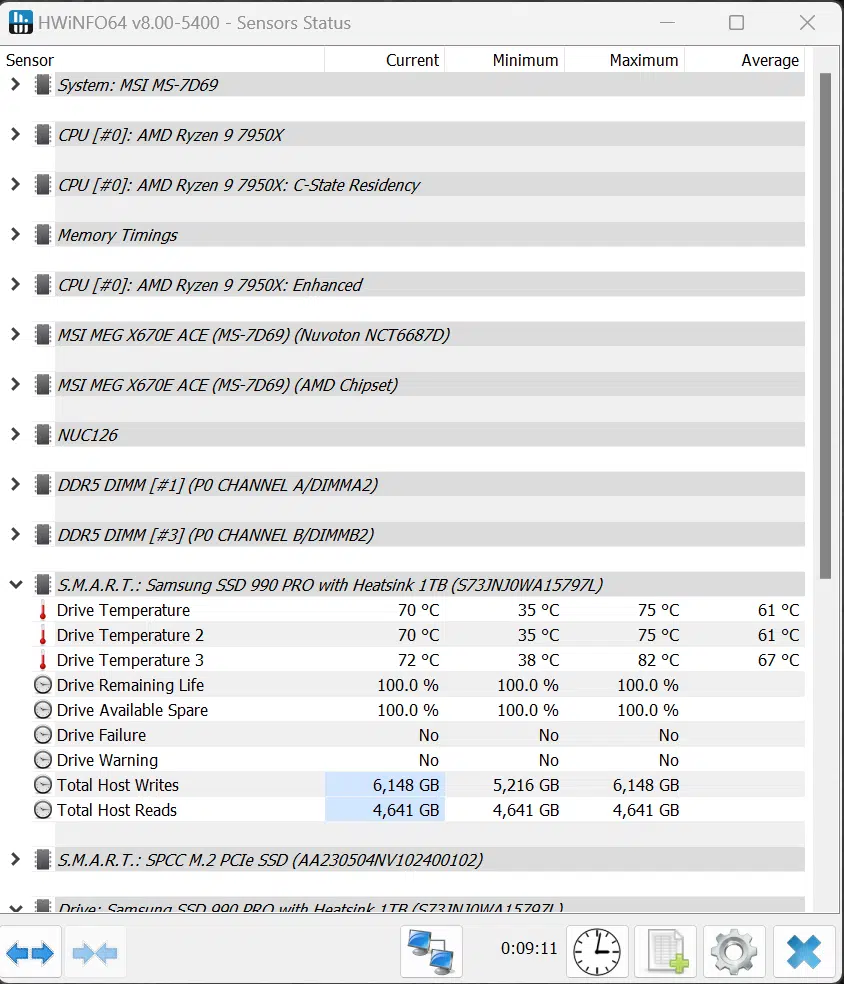Conclusion
We have put the Samsung 990 PRO w/Heatsink 1TB PCIe 4.0 NVMe SSD through its paces in system benchmarks, throughput benchmarks, game loading benchmarks, file copy benchmarks, and workstation benchmarks. The Samsung 990 PRO comes in two flavors, one with an integrated heatsink and one as a bare drive, to save a little money if you have your own motherboard heatsink or third-party heatsink.
Samsung also offers 1TB, 2TB, and 4TB models, and the exciting bit is that every capacity has the same rated performance of 7,450MB/s read and 6,900MB/s write. This puts the Samsung 990 PRO in the category of the fastest generation PCIe Gen4 SSDs. The Samsung 990 PRO is unique, as it uses Samsung’s own in-house controller and V-NAND flash and it does have an onboard DRAM-cache. Pricing is a premium, but that is not uncommon for Samsung SSDs.
Cooling
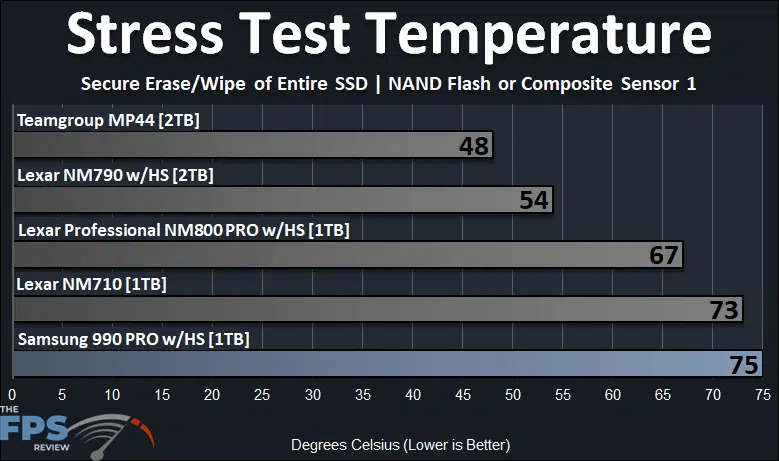
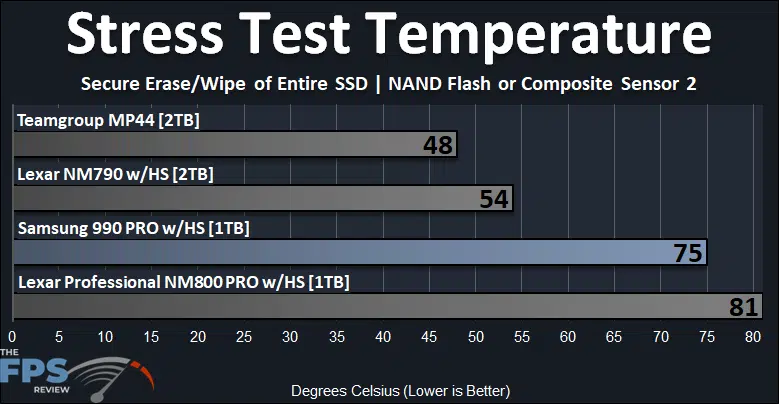
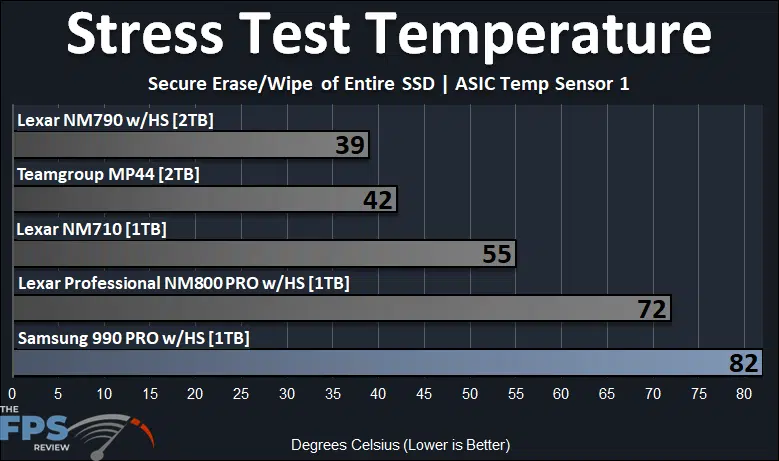
The goal of this temperature testing is to push the SSDs as hard as possible by writing to the SSD over the entire capacity using Secure Erase/Wipe feature. This is not typical usage behavior, but our goal is to find the maximum limits of the cooling in use and to see if it can keep up with a high demand of usage without adding external fans. We utilize HWiNFO64 for reporting SSD temperatures, taking note of all sensor data, either the (NAND Flash or Composite Sensor) or the (ASIC) sensor. We report what this utility shows us. No case fans are running during these tests.
The Samsung 990 PRO 1TB SSD we are testing is the model that includes a pre-installed heatsink. However, even with this heatsink, the Samsung 990 PRO 1TB SSD can reach some very high temperatures. We noted 75c on both Sensor 1 and 2 for the NAND flash/composite temperature reading. For Sensor 3 indicating ASIC temperature, or controller this reached 82c. These temperatures were warmer than even the Lexar NM800 PRO, which up until now was one of the warmest also with a heatsink. Under normal operation, it doesn’t reach these temps, but in a high-performance burst it could burst to these temperatures briefly.
In conclusion, we recommend good case airflow with this SSD, and if possible some air movement across the area where this SSD will be installed, especially if you intend to use it for intense, constant usage. If you buy the bare drive version, without a heatsink, install it with your motherboard M.2 heatsink, or a 3rd party heatsink, do not run it bare without passive or active cooling if you don’t want it to throttle.
Samsung Magician Software
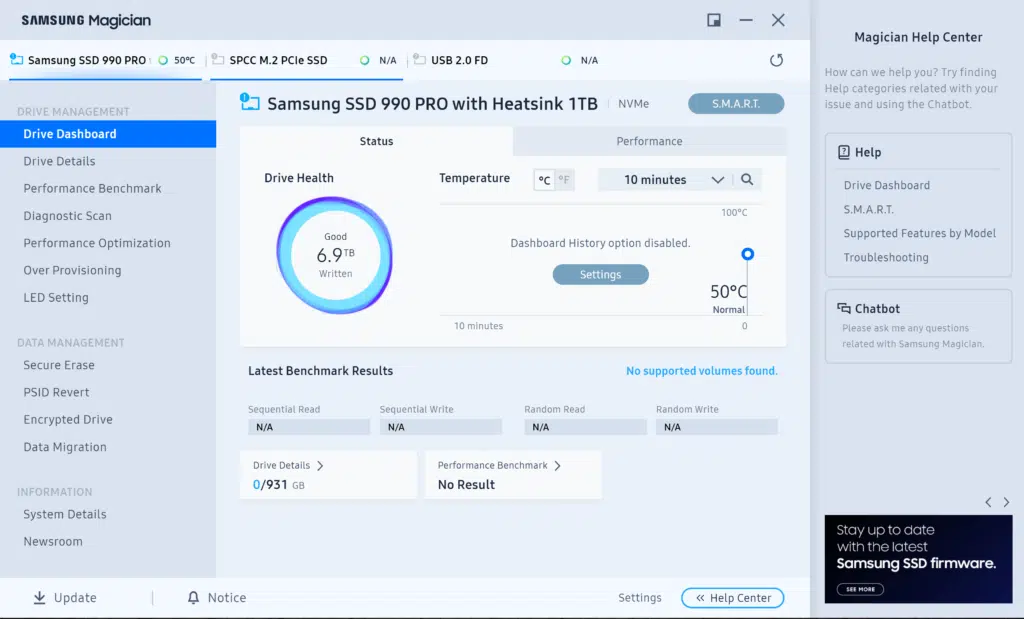

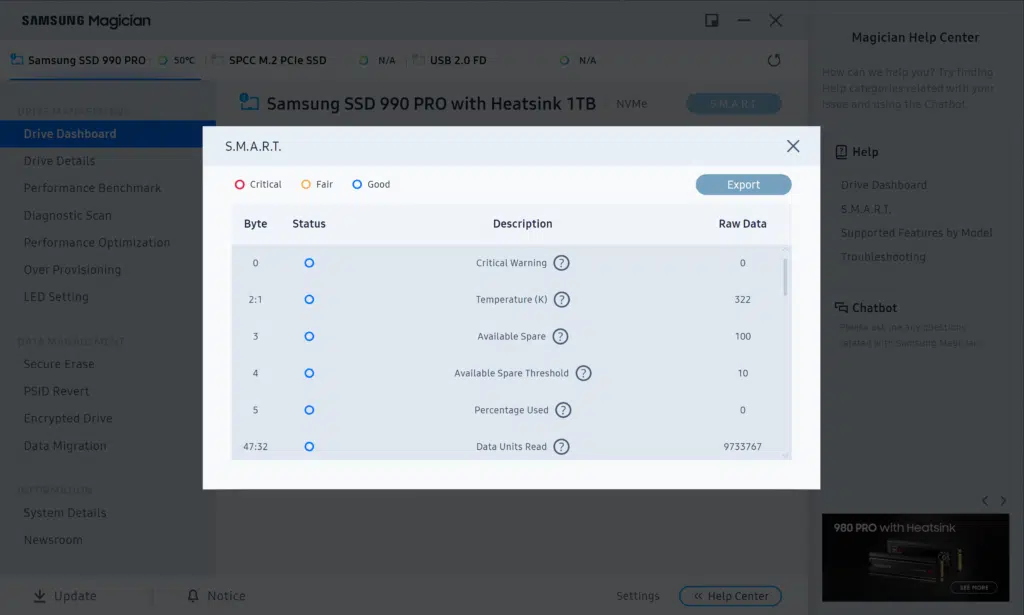
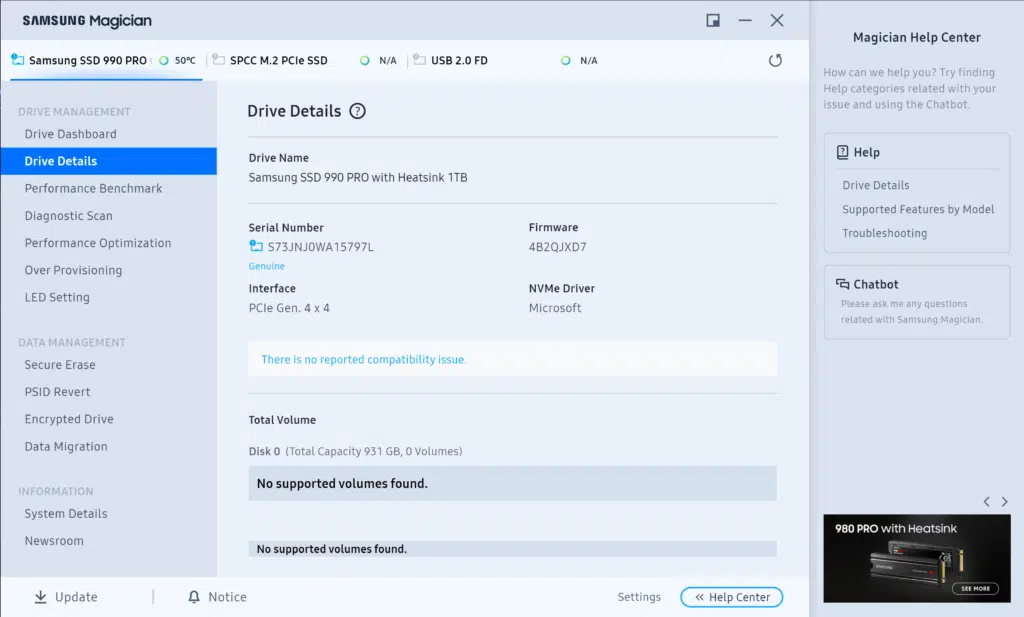
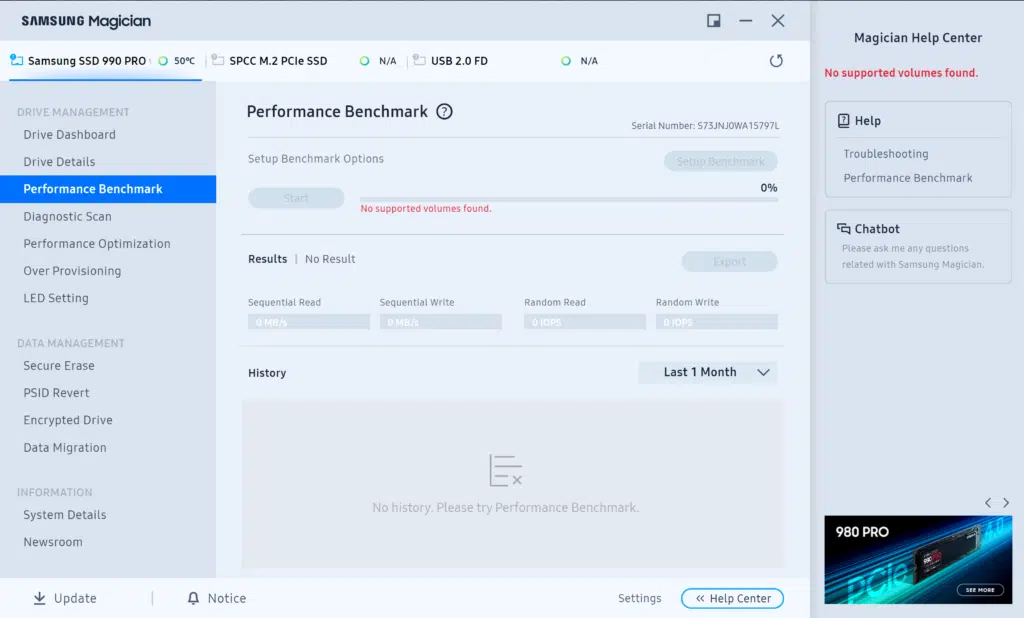
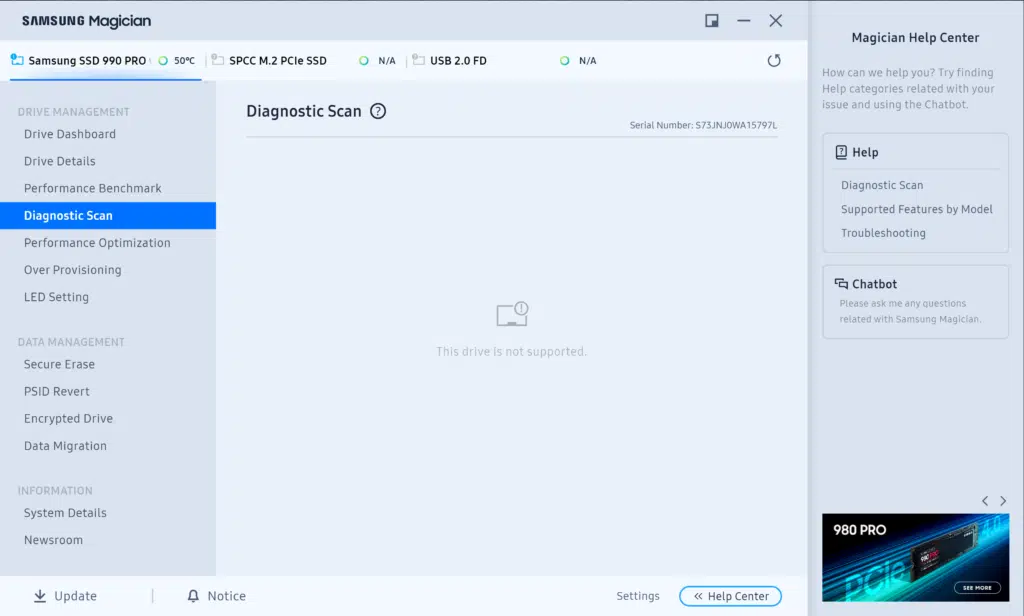
The Samsung Magician Software toolkit is some of the best in the industry for having features and options available for the SSD. The Samsun 990 PRO SSD is no exception. With this SSD you’ll have the ability to see dashboard information with drive health, temperature, and a history of temperatures as well that can be exported. It also has a performance tester built-in with the ability to save results, and export results, and view them over time to see if performance is degrading.
You can also update firmware, do a diagnostic scan, and enable performance optimization specific to the SSD. In addition, there is over-provision control, settings for the LED lighting, secure erase functions, encryption options, and data migration built-in. This software is really the gold standard in features for SSDs, and one from which all other SSD manufacturers need to learn from for functional features.
Final Points
The Samsung 990 PRO w/Heatsink 1TB PCIe 4.0 NVMe SSD is a great addition to Samsung’s SSD lineup when it launched in 2022, replacing the 980 PRO. Testing performance with the Samsung 990 PRO in 2024 proved to result in great performance across the board. We were impressed very specifically at the sequential write performance, which proved to exceed the competition.
We were also impressed at the random 4K performance in Q32T16 with the read and write performance blowing away everything else. It also had excellent access times, which helped it to exceed other SSDs in performance in PCMark 10 and 3DMark’s game testing. We also saw great game load times with modern games using DirectStorage, so it proves that the Samsung 990 PRO isn’t all about being for workstation applications, but it can also perform well for gamers.
There were some weaknesses that we discovered. It did have slower file copy time, and Steam Library copy times than the competition. It was also the slowest in random 4K Q1T1 testing. However, in workstation applications with SPECworkstation 3.1 it had the highest performance, meaning this “PRO” drive really can be a great option for professionals or content creators or workstation applications.
In terms of cooling, the Samsung 990 PRO can reach some high temperatures when being constantly written to, even with the pre-installed heatsink. It shouldn’t cause thermal throttling, but you may want to make sure you have airflow across the SSD if you are writing to the SSD continuously. In terms of endurance, the Samsung 990 PRO also falls below average for the rated Terabytes Written (TBW) endurance numbers. More recent Gen4 SSDs we have tested have higher endurance ratings, so despite the Samsung 990 PRO being a “PRO” drive, it is a bit lackluster in the endurance department for that description.
For whom the Samsung 990 PRO is for, performance is pretty incredible and the Samsung 990 PRO should fit well if you are a gamer, content creator, or workstation user. It will fit well in a laptop, or desktop PC, or small form factor, even with the pre-installed heatsink which we recommend. Having a DRAM cache is a good thing, and the performance really speaks for itself. We are a little underwhelmed with the endurance ratings considering it is a “PRO”, but compared to the Lexar NM800 PRO SSD, the other ‘professional’ SSD in this comparison today the Samsung 990 PRO proved to be the faster SSD in every regard.

